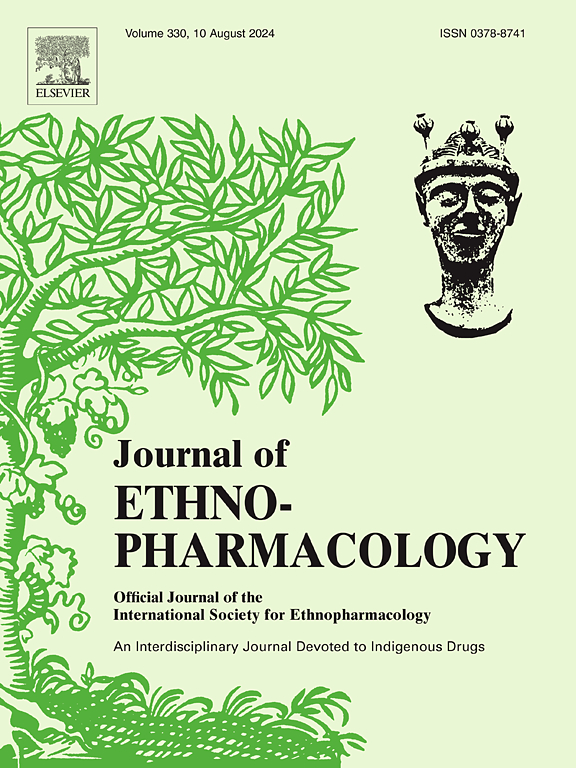Huoluo Xiaoling Pellet improves ischemic stroke by regulating metabolic disorders through integrins and ICAM1
IF 4.8
2区 医学
Q1 CHEMISTRY, MEDICINAL
引用次数: 0
Abstract
Ethnopharmacological relevance
Ischemic stroke (IS) is primarily caused by the stenosis or occlusion of cerebral arteries, leading to ischemic injury in brain tissue. Huoluo Xiaoling Pellet (HLXLP) is known for its efficacy in promoting blood circulation and removing blood stasis.
Aim of this study
This study aims to investigate the therapeutic effects of HLXLP on IS and elucidate its underlying mechanisms.
Materials and methods
Initially, we characterized the components of HLXLP that were absorbed into the bloodstream. Subsequently, potential therapeutic targets and active ingredients were explored through network pharmacology and analysis of GEO transcriptomic datasets. Further validation was conducted via compound similarity comparison, molecular docking, molecular dynamics simulation, and in vivo experiments. Finally, metabolomics was utilized to investigate the cerebral metabolic changes influenced by HLXLP.
Results
A total of 39 components of HLXLP were identified in the blood. Bioinformatics analysis revealed that ITGB1, ITGB2, ITGB3, ITGAL, and ICAM1 were identified as potential targets, which were confirmed in in vivo experiments. Metabolomics analysis indicated that HLXLP may alleviate the progression of IS by modulating the TCA cycle, cholesterol biosynthesis, and tryptophan metabolism in the brain.
Conclusion
This study demonstrates that HLXLP exerts its anti-IS effects by acting on targets such as ITGB1, ITGB2, ITGB3, ITGAL, and ICAM1 and modulating the TCA cycle, cholesterol biosynthesis, and tryptophan metabolism.

活络消灵颗粒通过整合素和ICAM1调节代谢紊乱改善缺血性脑卒中
缺血性脑卒中(IS)主要由脑动脉狭窄或闭塞引起,导致脑组织缺血性损伤。活络消灵丸(HLXLP)具有活血化瘀的功效。本研究旨在探讨HLXLP对IS的治疗作用,并阐明其作用机制。材料和方法首先,我们对HLXLP被血液吸收的成分进行了表征。随后,通过网络药理学和GEO转录组数据集分析,探索潜在的治疗靶点和有效成分。通过化合物相似性比较、分子对接、分子动力学模拟和体内实验进一步验证。最后,利用代谢组学研究HLXLP对脑代谢的影响。结果血中共检出39种HLXLP成分。生物信息学分析发现ITGB1、ITGB2、ITGB3、ITGAL和ICAM1是潜在靶点,并在体内实验中得到证实。代谢组学分析表明,HLXLP可能通过调节脑内TCA循环、胆固醇生物合成和色氨酸代谢来缓解IS的进展。结论本研究表明HLXLP通过作用于ITGB1、ITGB2、ITGB3、ITGAL和ICAM1等靶点,调节TCA循环、胆固醇生物合成和色氨酸代谢,发挥抗is作用。
本文章由计算机程序翻译,如有差异,请以英文原文为准。
求助全文
约1分钟内获得全文
求助全文
来源期刊

Journal of ethnopharmacology
医学-全科医学与补充医学
CiteScore
10.30
自引率
5.60%
发文量
967
审稿时长
77 days
期刊介绍:
The Journal of Ethnopharmacology is dedicated to the exchange of information and understandings about people''s use of plants, fungi, animals, microorganisms and minerals and their biological and pharmacological effects based on the principles established through international conventions. Early people confronted with illness and disease, discovered a wealth of useful therapeutic agents in the plant and animal kingdoms. The empirical knowledge of these medicinal substances and their toxic potential was passed on by oral tradition and sometimes recorded in herbals and other texts on materia medica. Many valuable drugs of today (e.g., atropine, ephedrine, tubocurarine, digoxin, reserpine) came into use through the study of indigenous remedies. Chemists continue to use plant-derived drugs (e.g., morphine, taxol, physostigmine, quinidine, emetine) as prototypes in their attempts to develop more effective and less toxic medicinals.
 求助内容:
求助内容: 应助结果提醒方式:
应助结果提醒方式:


